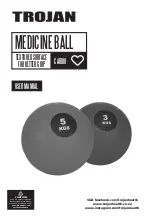
Free Call: 1800 723 405
│
Ph: (03) 9845 0300
│
Fax: + 61 3 9845 0350
│
INS0063
FEB 2015
Rev. I
Calibration Control Kit
Calibration verification of Hygiena SystemSURE Plus and EnSURE luminometers
Part No# PCD4000 (Kit Includes: 1 Positive Rod and 1 Negative Rod)
Description/ Intended Use:
Calibration control rods are used to verify calibration of Hygiena luminometers.
Positive Rod consists of C
14
radioactive source that emits very low level of
low-energy
β
radiation in a plastic scintillation matrix. Matrix is configured to
give constant light output at a high level for up to five years. Negative Rod is
used to check for possible background light getting into instrument or light
detector not calibrating correctly. Negative Rod produces low-light (0
–
4) RLU
background. It is recommended to verify calibration with Calibration Control Kit
each week or every other week depending on use and Quality Control
Program requirements. Incorporating Calibration Control Kit into overall
Quality Control program will validate luminometer is within specifications and
operating correctly.
Directions:
Positive and Negative Rods are inserted and read in luminometer in same
manner as ATP test devices.
Calibration rods do not need to be activated
like ATP test devices. Do not activate Calibration rods.
1. Open sample chamber and insert Positive Rod. Push rod in gently so it
makes contact with bottom of chamber.
2. Close lid and p
ress “OK” to initiate measurement.
3. Record result. Repeat steps 1 and 2 two more times and record results.
Calculate average of three readings and enter in table provided below.
Record Positive Rod Reference No. Refer to Interpretation of Results.
4. Repeat steps 1 through 3 using Negative Rod.
5. Repeat steps 1 through 4 for each luminometer. Record readings in table
provided below. Additional tables are printed on back side of this sheet.
Instrument Serial No.:
Positive Rod Reference No.:
Test 1
Test 2
Test 3
Average
Negative Rod
Test 1
Test 2
Test 3
Average
Interpretation of Results:
Refer to Table 1 below for acceptable RLU ranges. Results should not vary by
more than ± 20% from Positive Rod Reference No. If results from Positive Rod
are outside RLU range, or vary by > ±20% from Positive Rod Reference No.,
contact your Hygiena representative.
Table 1: In-Calibration RLU Ranges for Hygiena Luminometers
EnSURE (RLU)
SystemSURE Plus (RLU)
Negative Rod
0-4
0-4
Positive Rod
80-160
40-80
Incorporating Calibration Control Kit into a Quality Control Program:
Calibration Control Kit is designed to be incorporated into a Quality Control
Program that monitors and tracks performance of Hygiena luminometer and/or
devices. It is recommended that a specific program point be assigned in
luminometer for results. All results can be viewed directly from luminometer or
in SureTrend data analysis software.
Troubleshooting:
Several factors can cause RLU readings to be outside acceptable range.
Possible causes include:
Dirty calibration rods.
Clean outside of both rods with lint-free cloth that
has been dipped in isopropyl or ethyl alcohol. Air dry and repeat reading.
Damaged calibration rods.
Return damaged calibration rods to
Hygiena for replacement.
Luminometer contamination.
Results that have changed suddenly,
especially immediately after a number of sampling devices have been
run, can indicate contamination problems. Results from calibration rods
can increase or decrease as a result of foreign materials disturbing
optics chamber of luminometer. If contamination is suspected in
luminometer, remove read chamber and clean. Scratches on bottom of
read chamber do not affect readings. Refer to
owner’s manual for
instructions on cleaning read chamber.
Position of rod.
It is important to make sure calibration rods are placed
in read chamber so rod touches bottom of chamber. If rod does not
reach bottom of chamber, rod will be too far from sensor, and will result
in inaccurate results (low measurements).
Storage & Shelf Life:
Five (5) year shelf life. Refer to expiration date printed on label.
Store at 15
–
25 °C (59
–
77 °F) in box rods were received in, or dark
container. Store away from light.
Precautions:
Limit exposure to light.
Store calibration rods in dark or weak ambient
light. Kit box provided is recommended as appropriate dark storage. Do
not expose to direct sunlight or intense artificial light for too long before
use.
Handle with care.
Avoid crushing, cutting, or dropping calibration rods.
Any damage that changes shape or light transmission properties of
Positive Rod can affect assigned values. Do not use if scintillator tip of
device is cracked or damaged.
Radioactive material.
Not for human use. Introduction into foods,
beverages, cosmetics, drugs, or medicinal products, or into products
manufactured for commercial distribution is prohibited. Exempt quantities
should not be combined.
For further safety instruction, refer to Calibration Control Kit Safety Data
Sheet (SDS).
Disposal:
U.S. & Canada:
Level of radioactive material in Positive Rod does not
require special hazardous waste treatment, per U.S. Federal regulations
governing use and transfer of exempted radioactive materials. Contents
of Positive Rod are exempt from NRC or Agreement State licensing
requirements. Positive Rod contains extremely small amounts of
radioactive Carbon-14, completely contained by outer housing of device.
There are no radioactive emissions on surface of device, and no special
precautions are needed in handling device to avoid exposure.
To dispose of Positive Rod, remove or deface “Caution Radioactive
Materials” label on rod.
Positive Rod may then be disposed in trash.
For disposal requirements in other countries, check with your national or
local supplier.




















